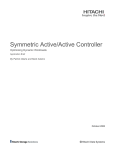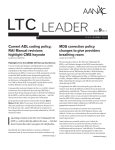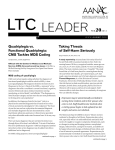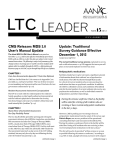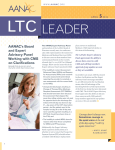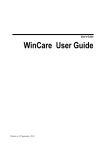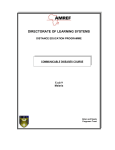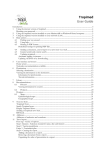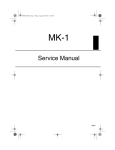Download LTC Leader BW 1121_02.indd
Transcript
LTC LEADER nov 21 2013 w w w. a a n ac .o r g A dash primer: Why “–” matters LTC professionals least likely to comply with immunization recommendations Caralyn Davis, ba, Staff Writer The use of the dash (-) on the MDS requires a balancing act. “Dashes absolutely shouldn’t be routine,” says Judy Wilhide Brandt, rn, ba, rac-mt, president of Judy Wilhide MDS Consulting in Virginia Beach, VA. “[CMS has] cautioned us not to use dashes unless we absolutely have to,” says Judy Wilhide Brandt, rn, ba, rac-mt. However, that doesn’t mean that dashing should be an incredibly rare event, points out Andrea Otis-Higgins, rn, mba, cdona , rac-mt, mlnha , CEO/administrator of St. Andre HealthCare Facility in Biddeford, ME. “According to the RAI User’s Manual for the MDS 3.0, there are times when dashes can be used legitimately. Dashes are indicated when you are unable to assess an item or the information was unavailable to you. In that regard, there is an allocation for the dash.” The key is to avoid excessive dashing, says Otis-Higgins. CMS addressed coding with dashes in its first web-based MDS 3.0 Provider Updates training video: Discharge Assessments and the Use of Dashes. The video came on the heels of several Skilled Nursing Facility/Long-term Care Open Door Forums where CMS officials cautioned providers against the too-frequent use of dashes, “particularly for unplanned discharge assessments,” says Otis-Higgins. Betty Frandsen, rn, nha, mha, c-ne-mt The Centers for Disease Control and Prevention (CDC) recently disclosed that long-term care providers are in last place among health care professionals when it comes to getting the influenza vaccine. Data shows that in the 2011 – 2012 influenza season, vaccination rates for health care workers in hospitals was 76.9%; for those in physicians’ offices, 67.7%; and for those working in nursing facilities the rate was 52.4%. Overall rates of immunization across all three areas of health care practice were 85.6% for physicians, 81.5% for nurse practitioners and physician assistants, 77.9% for nurses, 64.8% for other clinical personnel, and 59.3% for nonclinical staff. Because residents of nursing homes and other long-term care facilities are at higher risk for medical complications, they and the staff who care for them are recommended to receive the annual influenza vaccination. Vaccination before December is best so that antibodies are in place before flu activity is at its highest. Providers should always go the extra mile to complete assessments, stresses Brandt. “In the MDS 2.0, CMS said that dashes should be used if, after exhaustively searching, the data The CDC has declared the week of December 8 – 14, 2013, as National Influenza Vaccination Week. They recommend that everyone get vaccinated to protect against influenza, stating that vaccination before December is best so that antibodies are in place before flu activity is at its highest. Antibody protection typically develops within two weeks after vaccination. In the United States, influenza outbreaks typically occur through the fall and winter months. Although infection rates are highest among children, influenza-related complications, hospitalizations, and deaths have the highest rate of occurrence among adults aged 65 and older, as well as 50-to-64year-olds with underlying medical conditions. Children and continued on page 2 continued on page 4 “Apparently they have done some querying of the MDS database and seen more dashes than they would have expected,” adds Brandt. “So they have cautioned us not to use dashes unless we absolutely have to.” A dash primer, continued from page 1 remains unattainable,” she notes. “That is a really good standard to meet now as well. However, sometimes answering a particular question is just not feasible— the information remains unknowable. In that case, you are allowed to use the dash. But a dash should never be used to shirk your responsibility to assess the resident. It’s not an excuse not to do your job.” What can be dashed Most—but not all—MDS items can be dashed. Items that don’t allow dashes generally are found in Section A (identification information), Section I (active diagnoses), Section V (care area assessment summary), and Section X (correction request). However, the MDS 3.0 data submission specifications on the MDS 3.0 Technical Information webpage are the definitive source of information on whether a specific MDS item allows a dash. The data specs include Detailed Data Specifications Reports for every MDS section. The reports have an “Item Values” section that lists all allowable values (i.e., coding answers) for each MDS item. For example, according to the MDS 3.0 Submission Specs V1.13.2 for the October 1, 2013 Release, item A0050 (type of record) can only be coded with the values 1 (add new record), 2 (modify existing record), or 3 (inactivate existing record). If any other value, such as a dash, is submitted for this item, the result will be a fatal error on the Final Validation Report in the CASPER reporting application, meaning the MDS record will not be accepted into the QIES ASAP system until the error is corrected. Note: Section 7, “Nursing Home Final Validation Report,” of the CASPER Reporting User’s Guide for MDS Providers explains how to access and read Final Validation Reports. Section 5, “Error Messages,” of the MDS 3.0 Provider User’s Guide interprets warning and fatal error message numbers on the reports, offering tips and actions to resolve the potential problems that have been identified. 2 AANAC.org | 800.768.1880 Why excessive dashes hurt “Often providers don’t realize the impact of using dashes,” says Otis-Higgins. “They don’t understand how they will benefit from having a bit more diligence in gathering MDS data.” The primary reason why excessive dashes are a problem “is that they indicate you did not do the required assessment,” says Brandt. “Therefore, the resident is at risk for losing out on potential new or updated care plan interventions that will help him or her obtain the best outcomes. A secondary issue is that it is a condition of participation that you follow the MDS schedule.” Too many dashes also can indicate an integrity issue, says Brandt. “Sometimes facilities dash to cover up problems. For example, a facility puts a dash instead of coding a fall with a major injury, which is a QM issue.” What to watch for Common questions that come up about the use of dashes address the following topics: •Section I (active diagnoses). Inadvertent dashes can sometimes cause problems in I8000 (additional active diagnoses), says Otis-Higgins. “This item has to be either coded with ICD-9 codes or left blank (^). A dash isn’t allowed.” “[Dashes] indicate you did not do the required assessment,” says Brandt. “Therefore, the resident is at risk for losing out on potential new or updated care plan interventions that will help him or her obtain the best outcomes. Excessive dashing also can have “a significant impact on a facility’s quality measures (QMs) and, via a dotted line, the Five Star ratings,” says Otis-Higgins. For example, the use of dashes has the potential to reduce the size of a facility’s QM resident sample. Missing data also can distort the QMs, inaccurately representing a facility’s actual resident population and undermining its ability to show quality improvement. Last but definitely not least is the potential impact on payment, says Brandt. “If you have a dash in an item used for RUG payment, you’re not going to get the money.” Providers whose MDS assessments indicate excessive dashing should look for system issues, suggests Brandt. “For example, if a social worker consistently cannot complete interviews timely for standard quarterlies and is always dashing them, then that social worker needs education, guidance, and assistance from her bosses on time management.” •Section A (identification information). Item A2400C (end date of most recent Medicare stay) should be dashed if the Part A stay is ongoing because there is no end date yet. However, many items in Section A don’t allow dashes, points out Otis-Higgins. In the May 2013 RAI Manual update, CMS clarified that the dash isn’t an acceptable response in item A0800 (gender)—a choice of 1 (male) or 2 (female) must be made, says OtisHiggins. “If you are uncertain or if a patient declares as transgender, you look to how their gender is identified in the Social Security system. The gender documented in A0800 should match the Social Security gender. So code according to that.” Note: The Social Security gender is stated on the resident’s Medicare card. •Dashing date items. “For most MDS items that allow dashes, you single dash justified in the left-most box according to the instructions in the RAI Manual,” says Otis-Higgins. continued on page 6 A A N AC LT C L E A D E R 11. 21. 2 013 © 2013 AANAC. No part of this publication may be reproduced without written permission from AANAC. The information presented is informative and does not constitute direct legal or regulatory advice. Talkin’ the Talk ICD-10 AANAC ICD-10 Task Force When hearing of the impending implementation of ICD-10, the first thing that comes to mind is Really, another change?! Then the realization hits: This will happen, you must learn and change. The International Classification of Diseases, 9th Edition, Clinical Modification (ICD-9-CM) no longer reflects the care and services being provided in our current health care system. The International Classification of Diseases (ICD) was developed to collect uniform data for research and education, showing patterns of disease, and causes of death. ICD was revised in 1980 and this became the 9th edition of the classification. Who knew then that (just like our MDS, which was originally planned solely for quality) the ICD would be expanded to define DRGs/ RUGs/coverages and create auditing and Medical Necessity probes? As the AANAC Task Force for ICD-10 meets to help our members, the primary thought we all share is this: “What does all of this mean in understanding where we were, where we are now, and where we are going?” We decided we must first share the terminology with you, and hopefully you can share this information with your team. The date October 1, 2014, is very important, as this is the go-live date. This is when the 9th edition ends and the 10th edition begins. Understand, it will not be delayed, as there are many government initiatives in motion that require the “10” to occur, such as the 5010 billing process and the Transformed Medicaid Statistical Information System (T-MSIS), an actionable business intelligence software program. 3 AANAC.org | 800.768.1880 The MDS 3.0 manual provides explanations of coding requirements, and the official ICD-10-CM Coding Guidelines clarify why, how, and when you would code a disease or service. The guidelines are reviewed and approved by four organizations that make up the cooperating parties for the ICD-10-CM: the American Hospital Association (AHA), the American Health Information Management Association (AHIMA), the Center for Medicare & Medicaid Services (CMS), and the National Center for Health Statistics (NCHS). These guidelines are included in the official government version of the ICD-9-CM and also appear in Coding Clinic for ICD-9-CM, published by the AHA. Who is in charge? The WHO, not the rock band but the World Health Organization, published the ICD-10 and has appointed the Centers for Disease Control and Prevention’s (CDC) National Center for Health Statistics (NCHS) responsible for the implementation of ICD-10-CM and Procedure Classification System (PCS). This appointment fulfills the international obligations for comparable classifications and the national health data needs of the United States. What does that mean? Well, when you look on the CDC website, you can find out where the H1N1 (swine flu) is, where there is a yellow fever outbreak, information on the bird flu epidemic, and the seasonal increase in asthma due to molds and leaf burning. This reporting is based on the information in ICD codes. Whom does this impact? The transition to ICD-10-CM and PCS is required for everyone covered by the Health Insurance Portability Accountability Act (HIPAA). All of health care is changing to ICD-10-CM, with the exception of Current Procedural Terminology (CPT) coding for outpatient procedures and physician services; but they, too, must learn ICD-10-CM. Think about it: laboratory, X-ray, pharmacy, hospice, long-term care, acute care, clinics, etc.—changing from an estimated 9,000 to over 90,000 total codes in the transition from the 9th edition to the 10th edition. Don’t let that volume scare you; this is what they mean when they talk about “more specificity” in coding ICD-10-CM. With ICD-10-CM we have additional codes for right versus left (laterality), episodes of care, 7th-digit character extensions (level of care), and both alpha and numeric components; compare this to the 9th edition, which did not specify the side of the body or level of care and used only two alpha letters (V and E). Areas that will have the greatest impact on skilled nursing facilities will be: •Coding of fractures and using the 7th-digit character extensions to indicate subsequent level of care •Elimination of 18 Aftercare Fracture codes •Elimination of Late Effects •Coding of medication underdosing •Time changes for myocardial infarctions •Use of a placeholder “X” •Elimination of Hypertension table •Introduction of Z codes Under ICD-10-CM, as is the case under version 9, inconsistent, missing, and conflicting documentation must be resolved by the attending physician. As the MD presenter states in a free Medscape webinar (link provided on page 6), “If you are practicing good care, then there will be little change continued on page 6 A A N AC LT C L E A D E R 11. 21. 2 013 © 2013 AANAC. No part of this publication may be reproduced without written permission from AANAC. The information presented is informative and does not constitute direct legal or regulatory advice. LTC professionals least likely to comply with immunization recommendations, continued from page 1 working adults who acquire the illness often aren’t incapacitated by it or even very ill, so they continue going to school or work and share the virus with others. Because the influenza virus can circulate in water droplets in air for a period of time after a cough or sneeze, even after the person has left the room, the virus may remain, causing exposure for others. Influenza causes death each year for approximately 36,000 people in the United States. More than 90% of those who die are over the age of 65. Nursing facility outbreaks are reported each year; they vary from one in eight nursing facilities to as high as one facility in three. Skilled nursing facilities’ reported data shows that when outbreaks occur, one-third of the residents are affected and one-quarter of staff develop influenza-like illness. One in twenty of the infected residents dies. Gregory Gahm, md, of the Colorado Department of Public Health and Environment, reports that the financial impact of an influenza outbreak can be enormous. He offers the following scenario to demonstrate the reality of the impact. In a 100-bed facility, 34 residents will be diagnosed with influenza, and ultimately 2 will die. One-quarter of the staff will become sick and for three to seven days will be unable to work, so replacements will be needed. The 34 ill residents and the sick staff will receive antiviral medications, which cost approximately $100 per person. The other 66 residents and unvaccinated staff will also be placed on prophylaxis at $10 per person per day. Prophylaxis must continue for one full week after the last case is diagnosed, which extends from two weeks to one month or longer, and will result in a cost for antivirals of an additional $15,000 to $30,000. As the residents become sicker from the influenza, they will need more treatment for congestive heart failure, pneumonia, and other comorbidities. Dr. Gahm states that if every resident, staff member, vendor, visitor, and volunteer were vaccinated, an outbreak could likely be prevented. 4 AANAC.org | 800.768.1880 The CDC provides long-term care facilities with information designed to guide their preparation for flu season and outbreak management. Their article “Interim Guidance for Influenza Outbreak Management in Long-Term Care Facilities” recommends the following multifaceted approach: •Vaccination The CDC data attributes influenza outbreaks in long-term care facilities to low influenza vaccination coverage among health care personnel in those settings. Higher influenza vaccination rates among health care personnel in nursing home settings can reduce influenza-related illness and even prevent resident deaths. further states that administration of antiviral medication does benefit those who are very sick even if given after 48 hours. Oseltamivir pills or suspension and zanamivir disk inhaler are the recommended antivirals. Amantadine and rimantadine are not recommended due to high levels of resistance among circulating influenza A viruses. •Antiviral Chemoprophylaxis The CDC states that in a nursing facility with even one confirmed case of influenza, all residents—not just those on the same unit—should receive chemoprophylaxis. When two or more residents are ill within 72 hours of In a 100-bed facility, 34 residents will be diagnosed with influenza, and ultimately 2 will die. •Surveillance Active surveillance for influenza illness should be conducted daily for new and current residents, staff, and visitors, continuing until the end of flu season. Non-resident individuals who are ill should be excluded from the facility until their illness has resolved. •Testing Even if it is not influenza season, influenza testing should be conducted when any resident exhibits signs or symptoms of flu-like illness, as influenza can occur outside of the normal influenza season. Two or more confirmed cases constitutes an outbreak. •Infection Control For any residents suspected of or confirmed by laboratory testing as having influenza, implement standard and droplet precautions and continue for seven days after the onset of illness, or 24 hours after resolution of fever and respiratory symptoms, whichever is longer. •Antiviral Treatment All residents with suspected or confirmed influenza should receive antiviral treatment immediately. It is not recommended to wait until laboratory confirmation, as the medication is most effective if given within the first two days after symptoms develop. The CDC each other, and at least one of them has a confirmed case of influenza, chemoprophylaxis should begin in order to prevent transmission. This is intended for residents who are not ill or exhibiting signs or symptoms of influenza, and should continue for a minimum of two weeks, at least seven to ten days after the last case is identified. Antiviral prophylaxis should be considered for all employees, regardless of their vaccination status. To obtain additional information about the above CDC-recommended actions, visit the following link: http://www.cdc.gov/flu/professionals/ infectioncontrol/ltc-facility-guidance. htm. The CDC provides extensive information and educational materials for influenza prevention and management. Improved knowledge may result in better immunization rates among long-term health care professionals, so share the CDC facts with your team. The influenza immunization campaign is about doing all we can to protect our residents. � A A N AC LT C L E A D E R 11. 21. 2 013 © 2013 AANAC. No part of this publication may be reproduced without written permission from AANAC. The information presented is informative and does not constitute direct legal or regulatory advice. Q+A When a hospice resident clinically declines, is a Significant Change of Status Assessment required? When someone is enrolled in Hospice (the Hospice significant change MDS has already been done) and that person declines as would be expected, is another SCSA MDS required when the definition of SCSA is met or is the change expected just by virtue of being on Hospice and therefore a SCSA does not have to be done each time there is a decline? Thank you in advance for your response. I am unable to find any direction on this in either the regulations or the RAI manual. If the declines are expected due to the terminal diagnosis, no SCSA is required because the hospice SCSA was already completed. Carol Maher, rn-bc, rac-mt ([email protected]) Does Medicare Part B Therapy go against the 60-day wellness period for Skilled Care? I have a question on Medicare Part B starting after a resident has used all covered days with Medicare A. The resident used days in August and continued with all three disciplines ending with speech discontinuing in October. Is the last day of Part B coverage when you would start the recount for 60 days to get another 100 days of Medicare A benefit? Also, is there a certain amount of days on Part B that you would not count if they were on them after Medicare A days are used? The first day after the last day that the patient was receiving 5 days per week of therapy would be day 1 for your 60day count. The fact that the patient is receiving Part B therapy does not 5 AANAC.org | 800.768.1880 preclude the 60-day count from starting. What matters is whether the patient is receiving a skilled level of care. Part B therapy services rise to a skilled level of care when they are provided 5 days per week. 5 days per week of Part B therapy interrupts the 60-day “wellness” count toward obtaining a new benefit period. Mark McDavid, otr, rac- ct ([email protected]) Where can I find the most recent State Operations Manual (SOM) for nursing home regulations? What is the most recent version of the State Operations Manual (SOM)? I have one that was revised in 2011; the one on CMS website under the IOM is from 2004? Just need to make sure I have the most up-to-date version. The official version of the SOM is kept here: http://www.cms.gov/Regulationsand-Guidance/Guidance/Manuals/ Internet-Only-Manuals-IOMs-Items/ CMS1201984.html. Each chapter/ appendix has its own revision date, which you will find on the first page under the Table of Contents heading. These revision dates vary wildly. Typically, the most important sections for both skilled nursing facilities (SNFs) and nursing facilities (NFs) are Appendix P and Appendix PP. In addition, be aware that providers are responsible for implementing the draft updates to these appendices that CMS has released over the past year via survey-and-certification letters at http://www.cms.gov/Medicare/ Provider-Enrollment-and-Certification/ SurveyCertificationGenInfo/Policyand-Memos-to-States-and-Regions.html. Note that even though multiple updates have been released over the past year (and in late 2012 as well) and are now being enforced by state surveyors, these changes still have not made their way into the official SOM. The official version of Appendix PP, for example, has not been revised since January 2011. So you have to either keep track of all the S&C memo updates and incorporate them into your manual or find a manual publisher who has a system for doing that for you. Caralyn Davis, Staff Writer ([email protected]) My resident was out at Midnight; do I start the MDS schedule over? A resident returned from a hospital stay on November 6 as Medicare Part A. On November 7, this resident was sent out to the ER at 9:00 p.m. She was not admitted to the hospital and returned November 8 at 2:20 a.m., meaning she was not in her bed for census count at midnight. Billing is saying that because she wasn’t in her bed at midnight on November 7, Medicare cannot be billed and therefore her calendar starts over beginning November 8. Is this correct, and do I do a 5-day for November 6 to November 7h and then a readmit/return assessment when it is due counting from November 8? Your biller is half correct. You won’t bill for November 7. But you should not start the schedule over. November 7 becomes a skip day (LOA). Your Medicare schedule shifts by one day. November 6 is day one and November 8 is day two (November 7 is skipped). You must adjust your schedule to reflect this as you are still required to use allowable days for your ARDs for the entire 100-day cycle. Some software systems will account for this if your census reflects the LOA day correctly, and some folks have to track this shift manually. Rosie Hedrick ([email protected]) � A A N AC LT C L E A D E R 11. 21. 2 013 © 2013 AANAC. No part of this publication may be reproduced without written permission from AANAC. The information presented is informative and does not constitute direct legal or regulatory advice. AANAC Board of Directors Ruth Minnema, rn, ma, c-ne, rac-ct Chair Peter Arbuthnot, aa, ba, rac- ct Vice Chair Carol Maher, rn-bc, rac- ct Secretary Susan Duong, rn, bsn, nha, rac- ct, c-ne Treasurer Gail Harris, rn, bsn, rac- ct, c-ne Jo-Anna Hurd, rn, msn, rac- ct Stephanie Kessler, rac- ct Linda Krueger, rn, aas, ba, rac- ct Benjamin Ruggles, bsn, rn, rac-ct, c-ne, cpra Carol Smith, rn, bsn, rac- ct AANAC Expert Panel A dash primer, continued from page 2 “However, dating items that allow dashes are somewhat an exception in the directions on dashing. Typically when the date has not yet occurred or is unknown, you need to dash all eight of the spaces that have been allocated for that date.” For example, if a resident continues to receive ongoing physical therapy, occupational therapy, or speech-language pathology services, the therapy end date in O0400A6, O0400B6, and/or O0400C6 is filled with eight dashes. “The same is true with M0300B3 (date of oldest Stage 2 pressure ulcer) and A2400C (end date of most recent Medicare stay): Eight dashes would be used.” •Inconsistent dashing. “Often providers think about the MDS 3.0 as a collection of siloed items. However, in many ways, it is a highly integrated document,” says Otis-Higgins. “The inconsistent use of dashes—dashing one item but not another interconnected item—will create a logic error, often resulting in fatal errors on MDS submissions.” For example, if B0100 (comatose) is dashed, then all active items from E0100A (hallucinations) through E0300 (overall presence of behavioral symptoms) must be dashed as well. Note: Logic requirements for each item also are listed on the Detailed Data Specifications Reports. � AANAC is pleased to introduce you to our panel of volunteer reviewers who represent the best and the brightest in our field: Robin L. Hillier, cpa, stna, lnha, rac-mt President, RLH Consulting Becky LaBarge, rn, rac-mt Vice President, Clinical Reimbursement The Tutera Group Deb Myhre, rn, c-ne, rac-mt Nurse Consultant, Continuum Health Care Services Andrea Otis-Higgins, rn, mlnha , cdona , clnc, rac-mt CEO, Administrator, St. Andre Healthcare Biddeford, ME Judy Wilhide Brandt, rn, rac-mt, c-ne Regional MDS/Medicare Consultant President, Judy Wilhide MDS Consulting, Inc. Mark E. McDavid, otr, rac- ct Vice President of Professional Services, Rehab Management, Inc. Lisa Hohlbein, rn, rac-mt Director of Clinical Reimbursement, LeaderStat Jennifer LaBay, rn, rac-mt Director of Clinical Reimbursement, Health Concepts, Ltd Talkin’ the Talk, continued from page 3 in documentation for clinicians.” This webinar further explains that if organizations are expecting CMS to provide the items necessary to make the transition, they are mistaken. There are many useful tools available from CMS and others, but the responsibility for implementation lies with the provider. Although this webinar targets small physician practices, it presents principles that can assist anyone in the conversion to ICD-10-CM, including a slide presentation that appropriate nursing facility staff can use as a guide. To participate in the webinar, visit the following CMS webpage: http://www.cms. gov/Medicare/Coding/ICD10/index.html. Included on the webpage are two free Medscape education modules that offer guidance in making the transition to ICD10. They are ICD-10: A Roadmap for Small Clinical Practices and ICD-10: Small Practice Guide to a Smooth Transition. Continuing medical education (CME) and continuing education (CE) credits are available to physicians and nurses who complete the learning modules. If you are not a current Medscape user, you can create a free account in order to log in. Additionally, at AANAC, the ICD-10-CM Task Force will provide guidance and support during this challenging time by providing resource guides, planning and implementation tips, and a method of communication for your input. Over the next few months, we will present a series of articles designed to increase understanding, which can also be shared with facility team members. Watch future issues of LTC Leader and check our website for this valuable ICD-10-CM information. But the Medscape guidance is already there for you, so don’t wait to get started. � A ANAC ICD -10 Task Force Members: All the articles in this LTC Leader can also be found on the AANAC.org website. 6 AANAC.org | 800.768.1880 Casey Bastemeyer, rhit, cca , rac- ct Betty Frandsen, rn, mha , nha , c-ne Amy Franklin, cdon, rac-mt, rac- ct Leah Killian-Smith, lnha , rhia Judi Kulus, nha , rn, mat, rac-mt, c-ne Jennifer LaBay, rn, rac-mt, rac- ct Sharon Vandagriff, mba , rhia A A N AC LT C L E A D E R 11. 21. 2 013 © 2013 AANAC. No part of this publication may be reproduced without written permission from AANAC. The information presented is informative and does not constitute direct legal or regulatory advice.







